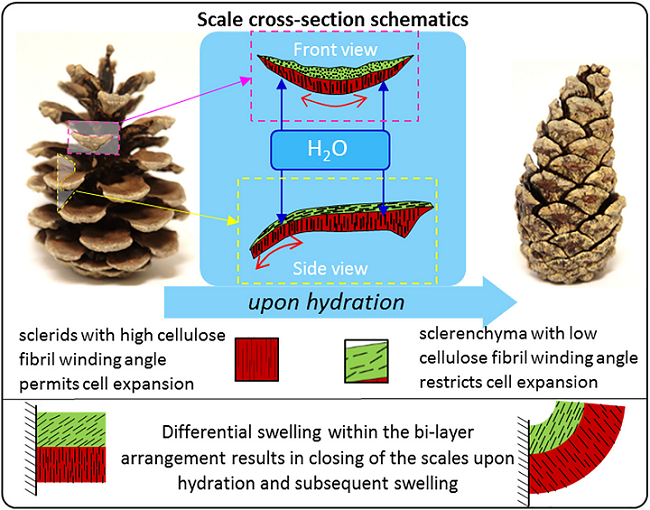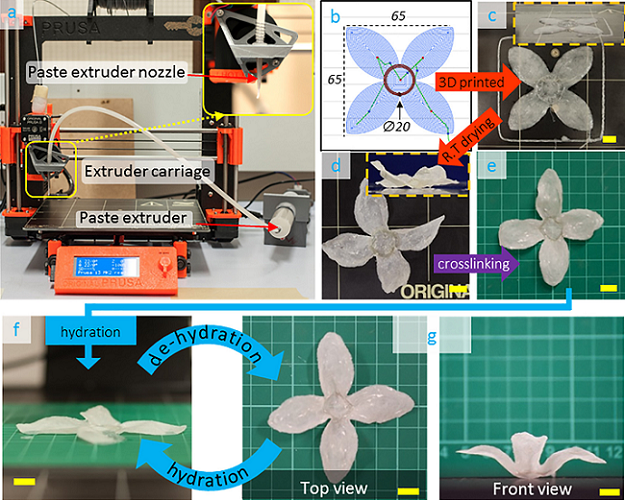We’ve seen the results of 3D printing research about responsive materials, but what about with 4D printing, where 3D printed objects can move and change shape of their own volition? A collaborative team of researchers from the University of Bristol and the University of Bath recently developed a responsive ink for 4D printing that’s both cost-effective and sustainable – important features for the adoption of 4D printing. The ink’s hydrogel matrix has a high total cellulose content, and a good dispersion of cellulose fibers as well.
 The team discussed the development of their new composite ink in a paper, titled “Responsive cellulose-hydrogel composite ink for 4D printing,” that was recently published in the Materials & Design journal.
The team discussed the development of their new composite ink in a paper, titled “Responsive cellulose-hydrogel composite ink for 4D printing,” that was recently published in the Materials & Design journal.
The abstract reads, “This paper focuses on the development of a cellulose-hydrogel composite ink for additive manufacture, presenting the development and physical characterisation (stability, swelling potential and rheology) of the cellulose-hydrogel composite to establish its suitability for 4D printing of responsive structures. The use of a carboxymethyl cellulose (CMC) hydrocolloid with incorporated cellulose pulp fibres resulted in an ink with a high total cellulose content (fibre volume fraction ≈50% for the dehydrated composite) and good dispersion of fibres within the hydrogel matrix. The The composite ink formulation developed in this study permitted smooth extrusion using an open source 3D printer to achieve controlled material placement in 3D space while retaining the functionality of the cellulose. The addition of montmorillonite clay not only resulted in enhanced storage stability of the composite ink formulations but also had a beneficial effect on the extrusion characteristics. The ability to precisely apply the ink via 3D printing was demonstrated through fabrication of a complex structure capable of morphing according to pre-determined design rules in response to hydration/dehydration.”
There are existing examples of 4D structures, or 3D structures that can morph over time, in nature, such as a pinecone’s ability to attract and hold water molecules from the surrounding environment. In order to realize this kind of responsive system following the design principles of nature, there are two requirements: a compliant stimuli responsive material, and a process that allows for the controlled placement of this material in order to achieve the response. Cellulose, which is the most abundant bio-macromolecule found in nature, is such a compliant stimuli-responsive material.
“Introduction of water to cellulose can result in plasticisation of the amorphous regions by weakening or relaxing hydrogen bonding through formation of competitive hydrogen bonds,” the researchers explained. “These intercalating water molecules result in swelling throughout the material, which can be used to drive the reversible actuation of specific architectures created by these materials.”
 To achieve this second requirement of a responsive system, 3D printing can be used. The technology offers plenty of control over placing materials in space, which makes it possible to design hybrid structures with “the hierarchical structural complexity characteristic of functional biological systems.”
To achieve this second requirement of a responsive system, 3D printing can be used. The technology offers plenty of control over placing materials in space, which makes it possible to design hybrid structures with “the hierarchical structural complexity characteristic of functional biological systems.”
Unfortunately, cellulose is not compatible in its natural form with most 3D printing methods. So, in order for 4D printing to continue advancing, we need to develop more stimuli responsive, 3D printable smart materials.
“To address this, this paper focuses on the development of a cost-effective, compliant “ink” material that can enable 3D printing of stimuli responsive complex forms to create programmable 4D structures. Moreover, the cellulosic ink will be specifically tailored for 3D printing using low-cost, open-source 3D printers ensuring the cellulosic composites thus fabricated are able to be further developed and extensively adopted in 4D printing research,” the researchers wrote.
“In this work, we have developed a stimuli responsive cellulosic pulp-hydrogel composite ink that is cost effective and bio-degradable. This composite ink is formulated for 3D printing and the stability, rheology and swelling potential of the ink has been characterised. A functional complex shape was fabricated using 3D printing to achieve precise material placement of the cellulosic ink, and the actuation via exposure to water demonstrated the ability to use this ink to produce 4D structures capable of programmable transformation.”
For their study, the team used sodium carboxymethyl cellulose (CMC-Na/CMC), a biocompatible, cellulose-derived polymer with great self-healing properties that’s often used as a thickening agent in the food and drug industry. Cotton derived pulp linters were used as a cellulosic fibre component, and the hydrogel was stabilized with clay. The resulting cellulose-hydrogel composites were able to be manually extruded through a syringe, and the team investigated the swelling response of the formulations, in addition to its rheological behavior.
Then, a custom off-axis direct driven paste extruder was integrated with a Prusa i3 MK2 3D printer, and the team validated the 3D printing capabilities, and subsequent 4D morphing, of their cellulose formulations with a morphing petal architecture, which has a programmed ‘through-thickness strain mis-match,’ which drives transformations. The specimen dried at room temperature, which initiated its transformation, and was later rehydrated in a room temperature water bath; it switched back to its 3D configuration once dry.
This actuation between the flat and 3D configurations of the object can be repeated several times, which shows that the team’s new composite ink has shape memory behavior.
The researchers wrote, “The development of a compliant composite cellulosic hydrogel integrating a high proportion of cellulosic material allowed use of a standard 3D printer to control material placement without compromising the responsiveness of the cellulose to hydration.”
By using 3D printing, researchers can achieve greater material placement precision, along with more complex architectures and actuation pathways for 4D printing. Because 3D printing parameters and design choices can significantly impact a material’s morphing behavior, it’s important to have a comprehensive understanding of just how these things can occur.
“Presently, the authors are exploring and devising experimental procedures to determine the influence these parameters; this will be reported in a subsequent publication,” the researchers concluded.
Co-authors of the paper are Manu C. Mulakkal, Richard S. Trask, Valeska P. Ting, and Annela M. Seddon.
Discuss this research and other 3D printing topics at 3DPrintBoard.com or share your thoughts below.
Subscribe to Our Email Newsletter
Stay up-to-date on all the latest news from the 3D printing industry and receive information and offers from third party vendors.
You May Also Like
3D Printing News Briefs, April 13, 2024: Robotics, Orthotics, & Hypersonics
In 3D Printing News Briefs today, we’re focusing first on robotics, as Carnegie Mellon University’s new Robotics Innovation Center will house several community outreach programs, and Ugogo3D is now working...
3D Printing Webinar and Event Roundup: March 24, 2024
We’ve got a very busy week of webinars and events, starting with Global Industrie Paris and a members-only roundtable for AM Coalition. Stratasys will continue its advanced in-person training and...
MIMO TECHNIK, ASTRO Test Lab & LEAP 71 Combine Powers for Computational Engineering in Aerospace 3D Printing
California-based MIMO TECHNIK, a service bureau catering to demanding clients in the New Space and defense sectors, operates with six SLM 500s, four SLM 280s, and three SLM 125s. ASTRO...
EOS Taps 1000 Kelvin for “First” AI Co-pilot for 3D Printing
Additive manufacturing (AM) startup 1000 Kelvin has joined forces with EOS to integrate AMAIZE, a pioneering artificial intelligence (AI) co-pilot for AM, into the EOS software suite. The solution aims...
































